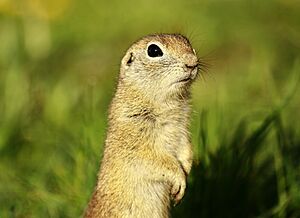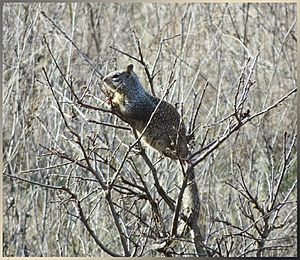Ground squirrel facts for kids
Quick facts for kids Ground squirrelTemporal range: Early Oligocene to recent
|
|
|---|---|
 |
|
| Ground squirrel in Turkey | |
| Scientific classification |
|
| Kingdom: | Animalia |
| Phylum: | Chordata |
| Class: | Mammalia |
| Order: | Rodentia |
| Family: | Sciuridae |
| Subfamily: | Xerinae |
| Tribe: | Marmotini Pocock, 1923 |
| Genera | |
|
Palaeosciurus (fossil) |
|
Ground squirrels are small, furry rodents that belong to the squirrel family. Unlike their tree-dwelling cousins, ground squirrels mostly live on the ground or in underground homes called burrows.
The name "ground squirrel" usually refers to medium-sized squirrels. Larger types are often called marmots or prairie dogs. Smaller ground squirrels with less bushy tails are known as chipmunks.
Contents
How Big Are Ground Squirrels?
Ground squirrels come in many sizes. They can be as small as about 18 centimeters (7.2 inches) tall. Some can grow much larger, nearly 76 centimeters (30 inches) tall.
Their weight also varies a lot. A small ground squirrel might weigh around 0.04 kilograms (0.09 pounds). The biggest ones can weigh up to 10.8 kilograms (24 pounds).
Where Do Ground Squirrels Live?
Ground squirrels like to live in open spaces. You can find them in rocky areas, fields, and grassy pastures. They also live on hillsides with few trees.
It's common to see them in places like golf courses, cemeteries, and parks. They prefer areas where they can easily dig their burrows.
How Ground Squirrels Stay Safe
Ground squirrels have clever ways to protect themselves from animals that might hunt them. When they sense danger, they make loud, high-pitched calls. These calls warn other squirrels in their group.
They spend about one-third of their time standing tall. This helps them watch for predators. If a predator is nearby, they will stop and watch it very carefully.

Ground squirrels are also amazing at digging. They build complex tunnel systems underground. These tunnels have many entrances, which are perfect escape routes. When danger comes, they quickly run into their burrows.
Their underground homes have many rooms and can be very long. Some tunnels range from 1.5 to 9 meters (5 to 30 feet) long. This makes it hard for predators to reach them. Their warning calls and burrow systems help ground squirrels survive in the wild.
What Do Ground Squirrels Eat?
Ground squirrels eat many different kinds of food. They are omnivorous, meaning they eat both plants and animals. Their diet often includes fungi, nuts, fruits, and seeds.
Sometimes, they also eat insects, eggs, and other small animals. This varied diet helps them get all the nutrients they need.
Types of Ground Squirrels
There are many different types of ground squirrels. Some are known as chipmunks, while others are marmots or prairie dogs. Scientists group them into different categories based on their features.
- Chipmunks: These are smaller ground squirrels.
- Marmots: These are larger ground squirrels, like the yellow-bellied marmot.
- Prairie dogs: These are known for living in large colonies and making barking sounds.
- True ground squirrels: This group includes many common ground squirrel species.
Related pages
Images for kids
-
A watchful "rock chuck" or yellow-bellied marmot (Marmota flaviventris) on Mount Dana, Yosemite National Park
See also
 In Spanish: Ardillas terrestres para niños
In Spanish: Ardillas terrestres para niños
- Tree squirrel
- Xerini—another group of ground squirrels found in Asia and Africa


